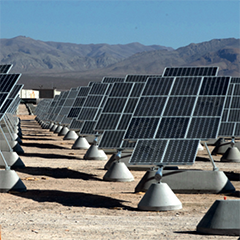Global energy consumption is steadily increasing, with an average increase in energy demand twice the year before. The demand was primarily met by fossil fuels, followed by renewable energy sources. In the year 2018, renewables accounted for more than 25% of global electricity supply capacity and this share is expected to increase significantly in the coming years.
The growing awareness about multiple advantages of solar energy such as cost-effectiveness and environmental benefits over fossil fuels is enabling governments to establish utility grade solar plants to power national grids. In addition to rising energy demand, the falling costs of solar power generation and ambitious environmental policies are encouraging new solar plants to be established.
The solar trackers are a key component in solar power system as much as PV cells and others. Initially, the fixed solar panels were used for only small-scale commercial or residential applications. However, as the popularity and demand for solar energy increased, new utility-scale commercial solar plants were established. Such solar plants required highly efficient solar tracking systems to ensure maximum energy output, hence there was a requirement of solar tracking systems capable of collecting solar energy throughout the day irrespective of the sun’s position. Ever since different type of solar trackers and tracking systems are used to orient solar panels towards the sun at all hours of the day. Today, solar trackers and solar tracking systems have become are critical components of utility-grade solar power plants.
The solar tracker market is one of the most lucrative market generating $3.90 billion in the year 2017 alone and expected to continue to grow at a cumulative average growth rate close to 25% from 2018 to 2025, according to the research study published by Adroit market research in December 2018. The same study specifies that the market value for solar trackers will cross $25 Billion in value by 2025.
This market is directly dependent on establishing new utility-grade solar plants as the adoption of solar trackers for residential or commercial use is currently lower. The factors such as rising energy demand, heavy consumption and decreasing reserves of fossil fuels are encouraging the establishment of new solar plants as an alternate energy source. Most importantly, rising environmental awareness and government initiatives to encourage the production of solar energy in major countries will significantly fuel the demand for solar trackers.
The most recent example of a government initiative to encourage solar energy production includes the International Solar Alliance between India and France announced in March 2018.This alliance will primarily focus on offering subsidies to new solar power projects to increase solar infrastructure in India. Similar government initiatives are ongoing across the regions, specifically in Asia, Latin America, and Africa which will subsequently fuel the market for solar trackers in the respective regions.


























